
Stephen, often referred to as Stephen of Blois, was King of England from 22 December 1135 to his death in 1154. He was Count of Boulogne jure uxoris from 1125 until 1147 and Duke of Normandy from 1135 until 1144. His reign was marked by the Anarchy, a civil war with his cousin and rival, the Empress Matilda, whose son, Henry II, succeeded Stephen as the first of the Angevin kings of England.

The Anarchy was a civil war in England and Normandy between 1138 and 1153, which resulted in a widespread breakdown in law and order. The conflict was a war of succession precipitated by the accidental death of William Adelin who drowned in the sinking of the White Ship in 1120. Henry sought to be succeeded by his daughter, known as Empress Matilda, but was only partially successful in convincing the nobility to support her. On Henry's death in 1135, his nephew Stephen of Blois seized the throne, with the help of Stephen's brother Henry of Blois, who was the bishop of Winchester. Stephen's early reign saw fierce fighting with disloyal English barons, rebellious Welsh leaders, and Scottish invaders. Following a major rebellion in the south-west of England, Matilda invaded in 1139 with the help of her half-brother Robert of Gloucester.
Roger Bigod was a Norman knight who travelled to England in the Norman Conquest. He held great power in East Anglia, and five of his descendants were earls of Norfolk. He was also known as Roger Bigot, appearing as such as a witness to the Charter of Liberties of Henry I of England.

Framlingham Castle is a castle in the market town of Framlingham, Suffolk, England. An early motte and bailey or ringwork Norman castle was built on the Framlingham site by 1148, but this was destroyed (slighted) by Henry II of England in the aftermath of the Revolt of 1173–1174. Its replacement, constructed by Roger Bigod, the Earl of Norfolk, was unusual for the time in having no central keep, but instead using a curtain wall with thirteen mural towers to defend the centre of the castle. Despite this, the castle was successfully taken by King John in 1216 after a short siege. By the end of the 13th century, Framlingham had become a luxurious home, surrounded by extensive parkland used for hunting.

Eye is a market town and civil parish in the north of the English county of Suffolk, about 4 miles (6 km) south of Diss, 17.5 miles (28 km) north of Ipswich and 23 miles (37 km) south-west of Norwich. The population in the 2011 Census of 2,154 was estimated to be 2,361 in 2019. It lies close to the River Waveney, which forms the border with Norfolk, and on the River Dove. Eye is twinned with the town of Pouzauges in the Vendée department of France.
Hugh Bigod, 1st Earl of Norfolk (1095–1177) was the second son of Roger Bigod, sheriff of Norfolk and royal advisor, and Adeliza, daughter of Robert de Todeni.
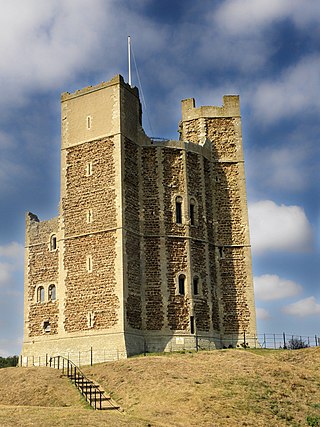
Orford Castle is a castle in Orford in the English county of Suffolk, 12 miles (19 km) northeast of Ipswich, with views over Orford Ness. It was built between 1165 and 1173 by Henry II of England to consolidate royal power in the region. The well-preserved keep, described by historian R. Allen Brown as "one of the most remarkable keeps in England", is of a unique design and probably based on Byzantine architecture. The keep stands within the earth-bank remains of the castle's outer fortifications.

Cambridge Castle, locally also known as Castle Mound, is located in Cambridge, Cambridgeshire, England. Originally built after the Norman conquest to control the strategically important route to the north of England, it played a role in the conflicts of the Anarchy, the First and Second Barons' Wars. Hugely expanded by Edward I, the castle then fell rapidly into disuse in the late medieval era, its stonework recycled for building purposes in the surrounding colleges. Cambridge Castle was refortified during the English Civil War but once again fell into disuse, used primarily as the county gaol. The castle gaol was finally demolished in 1842, with a new prison built in the castle bailey. This prison was demolished in 1932, replaced with the modern Shire Hall, and only the castle motte and limited earthworks still stand. The site is open to the public daily and offers views over the historic buildings of the city.

Wallingford Castle was a major medieval castle situated in Wallingford in the English county of Oxfordshire, adjacent to the River Thames. Established in the 11th century as a motte-and-bailey design within an Anglo-Saxon burgh, it grew to become what historian Nicholas Brooks has described as "one of the most powerful royal castles of the 12th and 13th centuries". Held for the Empress Matilda during the civil war years of the Anarchy, it survived multiple sieges and was never taken. Over the next two centuries it became a luxurious castle, used by royalty and their immediate family. After being abandoned as a royal residence by Henry VIII, the castle fell into decline. Refortified during the English Civil War, it was eventually slighted, i.e. deliberately destroyed, after being captured by Parliamentary forces after a long siege. The site was subsequently left relatively undeveloped, and the limited remains of the castle walls and the considerable earthworks are now open to the public.
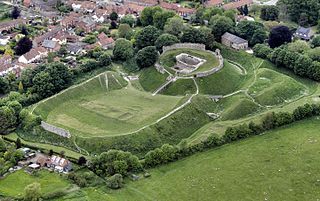
Castle Acre Castle and town walls are a set of ruined medieval defences built in the village of Castle Acre, Norfolk. The castle was built soon after the Norman Conquest by William de Warenne, the Earl of Surrey, at the intersection of the River Nar and the Peddars Way. William constructed a motte-and-bailey castle during the 1070s, protected by large earthwork ramparts, with a large country house in the centre of the motte. Soon after, a small community of Cluniac monks were given the castle's chapel in the outer bailey; under William, the second earl, the order was given land and estates to establish Castle Acre Priory alongside the castle. A deer park was created nearby for hunting.

Bedford Castle was a large medieval castle in Bedford, England. Built after 1100 by Henry I, the castle played a prominent part in both the civil war of the Anarchy and the First Barons' War. The castle was significantly extended in stone, although the final plan of the castle remains uncertain. Henry III of England besieged the castle in 1224 following a disagreement with Falkes de Breauté; the siege lasted eight weeks and involved an army of as many as 2,700 soldiers with equipment drawn from across England. After the surrender of the castle, the king ordered its destruction (slighting).

Bowes Castle is a medieval castle in the village of Bowes in County Durham, England. Built within the perimeter of the former Roman fort of Lavatrae, on the Roman road that is now the A66, the early timber castle on the site was replaced by a more substantial stone structure between 1170 and 1174 on the orders of Henry II. A planned village was built alongside the castle. Bowes Castle withstood Scottish attack during the Great Revolt of 1173–74 but was successfully looted by rebels in 1322. The castle went into decline and was largely dismantled after the English Civil War. The ruins are now owned by English Heritage and run as a tourist attraction. There is free admission during daylight hours.

Chichester Castle stood in the city of the same name in West Sussex. Shortly after the Norman Conquest of England, Roger de Montgomery ordered the construction of a castle at Chichester. The castle at Chichester was one of 11 fortified sites to be established in Sussex before 1100. The Rape of Chichester, a subdivision of Sussex, was administered from the castle and was split off from the larger Rape of Arundel; a Rape was an administrative unit originating in the Saxon era and continued by the Normans. Situated in the north-east corner of Chichester, the castle was protected by the city walls. As it was an urban castle inserted into a pre-existing settlement, buildings were probably cleared to make way for the castle. Chichester Castle was of timber construction; although some timber castles were rebuilt in stone, there is no evidence that this was the case at Chichester.
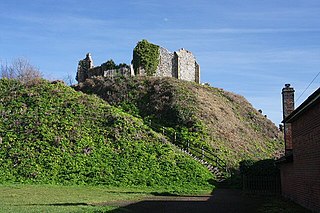
Eye Castle is a motte and bailey medieval castle with a prominent Victorian addition in the town of Eye, Suffolk. Built shortly after the Norman conquest of England in 1066, the castle was sacked and largely destroyed in 1265. Sir Edward Kerrison built a stone house on the motte in 1844: the house later decayed into ruin, becoming known as Kerrison's Folly in subsequent years.

Haughley Castle was a medieval castle situated in the village of Haughley, some 4 kilometres (2.5 mi) north-west of the town of Stowmarket, Suffolk. Prominent historians such as J. Wall consider it "the most perfect earthwork of this type in the county," whilst R. Allen Brown has described it as "one of the most important" castle sites in East Anglia.
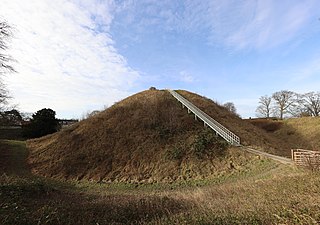
Thetford Castle is a medieval motte and bailey castle in the market town of Thetford in the Breckland area of Norfolk, England. The first castle in Thetford, a probable 11th-century Norman ringwork called Red Castle, was replaced in the 12th century by a much larger motte and bailey castle on the other side of the town. This new castle was largely destroyed in 1173 by Henry II, although the huge motte, the second largest man-made mound in England, remained intact. The motte, recognised as a scheduled monument, now forms part of a local park, and the remains are known variously as Castle Hill, Castle Mound and Military Parade.
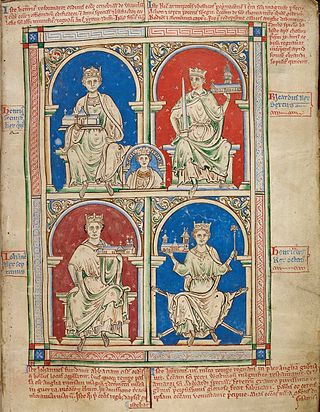
England in the High Middle Ages describes the history of England between the Norman Conquest in 1066 and the death of King John, considered by some historians to be the last Angevin king of England, in 1216. A disputed succession and victory at the Battle of Hastings led to the conquest of England by William of Normandy in 1066. This linked the Kingdom of England with Norman possessions in the Kingdom of France and brought a new aristocracy to the country that dominated landholding, government and the church. They brought with them the French language and maintained their rule through a system of castles and the introduction of a feudal system of landholding. By the time of William's death in 1087, England formed the largest part of an Anglo-Norman empire, ruled by nobles with landholdings across England, Normandy and Wales. William's sons disputed succession to his lands, with William II emerging as ruler of England and much of Normandy. On his death in 1100 his younger brother claimed the throne as Henry I and defeated his brother Robert to reunite England and Normandy. Henry was a ruthless yet effective king, but after the death of his only male heir William Adelin, he persuaded his barons to recognise his daughter Matilda as heir. When Henry died in 1135 her cousin Stephen of Blois had himself proclaimed king, leading to a civil war known as The Anarchy. Eventually Stephen recognised Matilda's son Henry as his heir and when Stephen died in 1154, he succeeded as Henry II.

Worcester Castle was a Norman fortification built between 1068 and 1069 in Worcester, England by Urse d'Abetot on behalf of William the Conqueror. The castle had a motte-and-bailey design and was located on the south side of the old Anglo-Saxon city, cutting into the grounds of Worcester Cathedral. Royal castles were owned by the king and maintained on his behalf by an appointed constable. At Worcester that role was passed down through the local Beauchamp family on a hereditary basis, giving them permanent control of the castle and considerable power within the city. The castle played an important part in the wars of the 12th and early 13th century, including the Anarchy and the First Barons' War.

Southampton Castle was located in the town of Southampton in Hampshire, England. Constructed after the Norman conquest of England, it was located in the north-west corner of the town overlooking the River Test, initially as a wooden motte and bailey design. By the late 12th century the royal castle had been largely converted to stone, playing an important part in the wine trade conducted through the Southampton docks. By the end of the 13th century the castle was in decline, but the threat of French raids in the 1370s led Richard II to undertake extensive rebuilding. The result was a powerfully defended castle, one of the first in England to be equipped with cannon. The castle declined again in the 16th century and was sold off to property speculators in 1618. After being used for various purposes, including the construction of a Gothic mansion in the early 19th century, the site was flattened and largely redeveloped. Only a few elements of the castle still remain visible in Southampton.
Malmesbury Castle was a castle in the town of Malmesbury, Wiltshire, England.

















